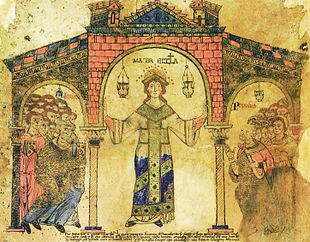Mother church

Mother Church ( Latin Mater Ecclesia ), often also Holy Mother Church ( Latin Sancta Mater Ecclesia ), is an expression of Catholic ecclesiology and piety . The sacramental healing Community Church is with this image as a child of God giving birth and their faith nourishing mother described.
In Galatians called Paul the " heavenly Jerusalem " as "our mother" ( Gal 4,26 EU ). This became a popular theological and homiletic motif among the church fathers since Irenaeus of Lyon (135-200) . One of the best-known statements is the saying of Cyprian of Carthage : that no one can have God as a father who does not have the church as a mother ( Habere non potest Deum patrem qui ecclesiam non habet matrem ).
The popes of all centuries used the term frequently in their instructional letters, for example Pope John XXIII in 1963 . with its social encyclical Mater et magistra : "Mother and teacher of the peoples is the Catholic Church." The Second Vatican Council takes in its church constitution Lumen Gentium (No. 6) the biblical designation of the church as "our mother" (Gal 4,26; cf. Rev 12,17 EU ); her motherliness is shown by the fact that she guides people through word and sacrament like a mother leads her children. In the liturgy the term u. a. in the Exsultet of Easter Vigil, in the second church consecration - prefecture and in the song A large city arises from Silja Walter ( God's praise 479).
Although Martin Luther - according to the overwhelming opinion of the hymnologists - describes the church as a mother in his song She is dear to me, the valued maid in connection with Rev 12 EU , the expression was no longer used in the churches of the Reformation, as it superseded the seemed to legitimize the church hierarchy through the “ lay people ”. For the same reason it only plays a minor role in post-conciliar Catholic ecclesiology and spirituality; instead the title of Mary as Mother of the Church was reasserted.
The Catechism of the Catholic Church only briefly mentions the term mother church among other ecclesiological images.
Pope Francis , as a loving mother modeled on Mary, made the Church the subject of his speeches at the general audiences on September 3 and 10, 2014.
See also
literature
- Medard Kehl : Mother Church . In: Walter Kasper (Ed.): Lexicon for Theology and Church . 3. Edition. tape 7 . Herder, Freiburg im Breisgau 1998, Sp. 561 f .
Web links
Individual evidence
- ↑ Bernhard Sesboüé: Fathers of the Church: ecclesial thinking from the beginnings to modern times . Paderborn 2004, p. 111
- ↑ Cyprian: De unitate ecclesiae 6; Peter Neuner : Ecclesiology. Doctrine of the Church. In: Wolfgang Beinert (ed.): Faith accesses. Textbook of Catholic Dogmatics. Volume 2. Paderborn a. a. 1995, pp. 399-578, here p. 477.
- ^ Peter Neuner: Ecclesiology. Doctrine of the Church. In: Wolfgang Beinert (ed.): Faith accesses. Textbook of Catholic Dogmatics. Volume 2. Paderborn a. a. 1995, pp. 399-578, here p. 476f.
- ↑ Laetetur et mater Ecclesia - “ May the Mother Church also rejoice”.
- ↑ "You sanctify her day by day until you receive her, our mother, into glory with the innumerable host of her children."
- ↑ “Through your gate let us in / and be born in you, / so that God may know us. / Let in who are outside; / God means daughter, son and child / whoever calls you mother ”(text version 2013).
- ↑ Address by Paul VI. before the council meeting on November 21, 1964 , No. 30 (Italian)
- ^ Catechism of the Catholic Church 757 ( online )
- ↑ Address on September 3, 2014 ; Address on September 10, 2014